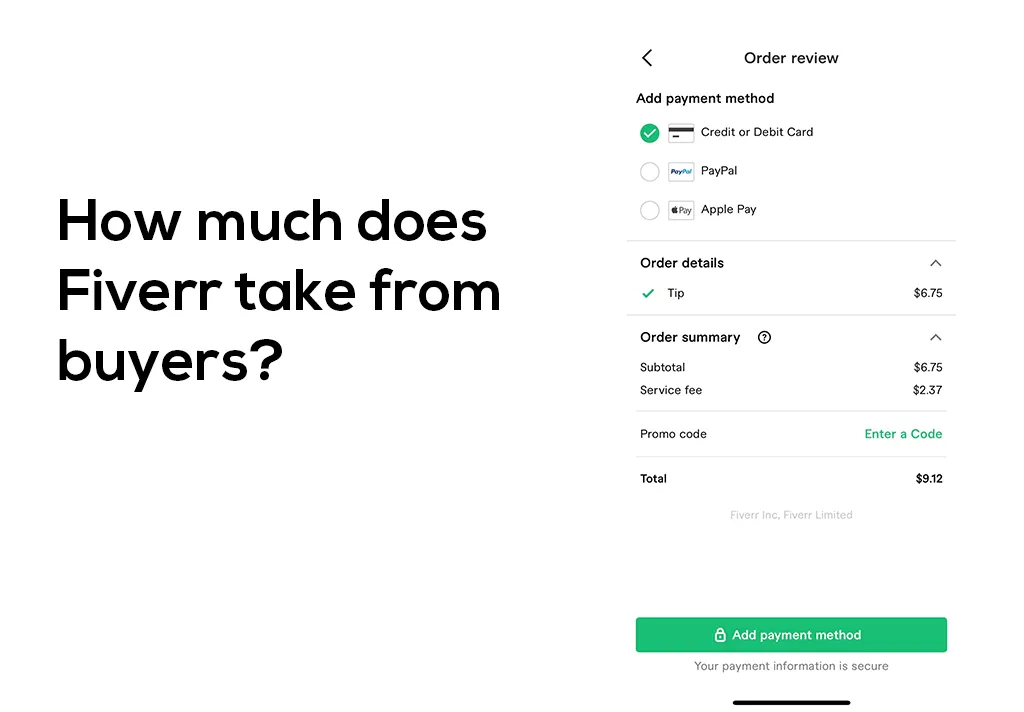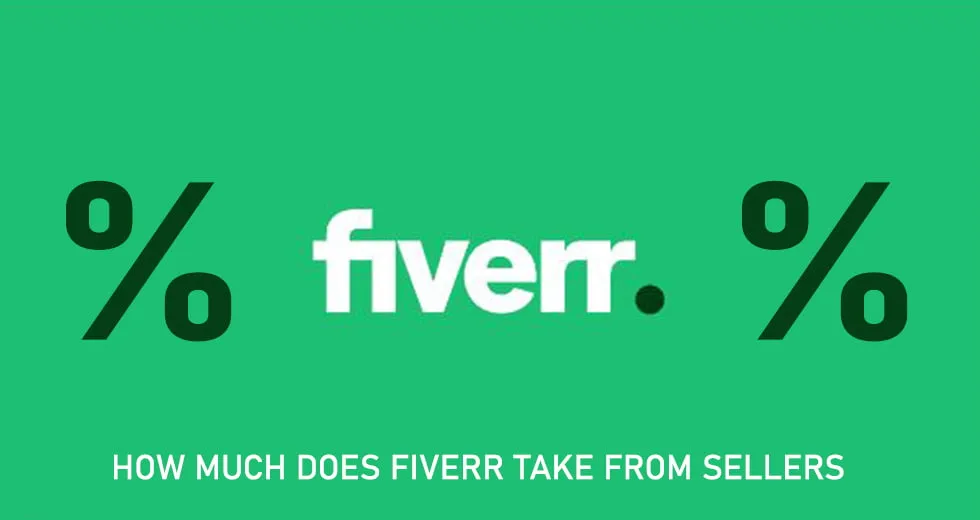Freelancing platforms like Fiverr have opened up a world of opportunities for creative professionals. However, one common question that floats around is, "How much of a cut does Fiverr take?" Understanding Fiverr’s fee structure is crucial for freelancers looking to maximize their earnings. In this post, we’ll break down how Fiverr takes its fees, so you can get a clear picture of your earnings when working through this popular platform.
The Fiverr Fee Structure

Fiverr’s fee structure is designed to provide a seamless experience for both buyers and sellers, but it can feel a bit overwhelming at first. Let’s delve into how the fees are structured and what you can expect when you start selling services on this platform.
- Service Fee: Fiverr takes a 20% commission on every transaction you make. This means that if you set your gig price at $100, you’ll actually earn $80 after the deduction. It’s straightforward: the more you sell, the more Fiverr benefits.
- Withdrawal Fees: When you decide to withdraw your earnings, Fiverr charges a fee based on the method you choose. For example:
- Custom Offer Fees: If you’re creating a custom offer for a client, the same 20% fee applies, which can sometimes come as a surprise if you’re not prepared for it.
- Additional Add-Ons: Fiverr has various add-ons available, like gig extras or gig packages, but remember these factors can also be subject to the 20% fee. So, if you upsell, calculate your earnings carefully.
| Withdrawal Method | Fee |
|---|---|
| PayPal | Varies (around $1) |
| Bank Transfer | $3 |
| Direct Deposit | Varies based on bank institution |
Overall, while Fiverr’s fee structure may initially seem steep, many freelancers find the platform’s reach and user base compensate for these costs. Familiarizing yourself with how much Fiverr takes can help you set more competitive prices and ultimately increase your profits.
Also Read This: How to Put Fiverr Link on Instagram
Understanding Fiverr's Service Fee

So, let’s talk about the nitty-gritty of Fiverr's service fees! When you dive into the gig economy, it’s essential to know how much you'll keep of your hard-earned cash. As a seller on Fiverr, you might be wondering, "What portion of my earnings goes to Fiverr?" Well, here’s the scoop.
Fiverr typically takes a *20% cut from your total earnings on each order. This means if you sell a gig for $100, you will receive $80 after Fiverr takes its share. It’s a significant slice, isn’t it? Here’s a quick breakdown:
| Order Amount | Fiverr's Cut (20%) | Your Earnings |
|---|---|---|
| $50 | $10 | $40 |
| $100 | $20 | $80 |
| $200 | $40 | $160 |
It’s also worth mentioning that this fee applies to tips and extras that buyers might add on. So, if you provide a fantastic service and receive a $20 tip, Fiverr will take $4 from that too. While the fee might seem hefty, the platform provides a range of tools, support, and visibility to help you grow your freelancing career. Plus, the convenience of having everything in one place is hard to beat!
Also Read This: How to Get Back Your Disabled Fiverr Account
Impact of Rates on Sellers and Buyers
Now that we know about Fiverr's service fees, let’s take a moment to discuss how these rates impact both sellers and buyers on the platform. It's crucial to understand the dynamics at play here, as they influence pricing strategies and purchasing decisions.
For sellers, the 20% service fee* can be a double-edged sword. On one hand, it can motivate sellers to set higher rates to offset the fee. On the other hand, it can deter newcomers who fear that they won’t see much profit from their work. Here's how it typically affects sellers:
- Price adjustments: Many sellers balance their prices to maintain competitiveness while ensuring they cover costs.
- Value perception: Higher fees might compel sellers to highlight the value they provide through quality gig descriptions and add-ons.
- Revenue growth: As sellers gain experience and positive reviews, they often find ways to increase their prices, improving overall earnings despite the cut.
For buyers, the impact is slightly different. Buyers on Fiverr may find that while the fees add to the overall cost of hiring freelancers, they often still perceive the value in the platform’s convenience and variety of options. Here’s what buyers experience:
- Budget considerations: Buyers may need to adjust the budget to accommodate for the service fees, especially for larger projects.
- Quality assurance: The service fee can imply to buyers that they’re paying for a platform that verifies sellers, hopefully ensuring quality work.
- Negotiation flexibility: Knowing Fiverr takes a cut, some buyers are willing to negotiate prices or tip generously for exceptional service.
In summary, the service fees are a significant factor on Fiverr that influences how both sellers price their services and how buyers strategize their purchasing decisions. Understanding these dynamics can help you navigate the platform like a pro!
Also Read This: What is a Package in Fiverr?
Comparing Fiverr’s Fees with Other Freelance Platforms
When you’re looking to hire or offer services online, it’s crucial to understand the financial landscape of various platforms. Fiverr is just one of many options, and comparing its fees with other freelance platforms can give you a clearer picture of what to expect. Let’s break it down:
- Fiverr: Fiverr typically takes a 20% commission from the total earnings. This means that if you sell a gig for $100, you’ll walk away with $80.
- Upwork: Upwork’s fees vary based on your earnings with a specific client. They charge 20% for the first $500, 10% from $500.01 to $10,000, and 5% for anything over $10,000. So, as your relationship with clients grows, you get to keep more of your hard-earned cash!
- Freelancer: Freelancer.com has a bit of a mixed bag with their fees. They charge a 10% fee if you’re working on a fixed-price project and a $5 fee for hourly projects, which can add up if you’re consistently working!
- PeoplePerHour: Here, the fees can range from 20% for your first $250 earned to 3.5% after that, which can be a real incentive to build lasting client relationships.
Clearly, each platform has its own set of rules and commissions. It’s essential to factor in these fees when deciding where to offer your services. The choice ultimately depends on your specific needs and how much you’re willing to pay for the privilege of using a platform.
Also Read This: How to Get Popular on Fiverr
How to Maximize Your Earnings on Fiverr
Are you ready to boost your Fiverr income? Sure, Fiverr takes a cut, but there are ways to make that commission worth it. Here’s how you can maximize your earnings:
- Polish Your Profile: First impressions matter! Ensure your profile is complete, professional, and reflects your unique brand. Use a friendly profile picture and write a compelling bio that showcases your skills.
- Optimize Gig Titles and Descriptions: Keywords are your best friends! Use relevant keywords in your titles and descriptions to improve your search rankings. Make sure your descriptions clearly outline what you offer, and don’t forget to mention what makes you unique.
- Create Attractive Pricing Packages: Offer different tiers of service. For example, a basic, standard, and premium package gives clients options and opens the door for upselling additional features.
- Deliver Quality Work: This might seem obvious, but delivering top-notch work will lead to positive reviews and repeat clients, ensuring a steady stream of income. Focus on exceeding client expectations!
- Promote Your Gigs: Don’t solely rely on Fiverr’s internal traffic. Share your gigs on social media, your personal website, and within relevant online communities to attract more clients.
With these strategies in place, you can not only increase your visibility on Fiverr but also make the most of your earnings despite the platform’s cut. Remember, the goal is not just to earn more, but to build a sustainable freelance business!
How Much of a Cut Does Fiverr Take?
Fiverr is a popular online marketplace that connects freelancers with clients seeking various services, from graphic design to content writing. One of the most common questions asked by new users is, “How much of a cut does Fiverr take from my earnings?” Understanding Fiverr’s fee structure is crucial for freelancers to ensure their pricing aligns with their expected income.
Fiverr operates on a simple commission model:
| Fiverr Fee | Details |
|---|---|
| Service Fee | Fiverr takes a %20 commission on each transaction. This means if you sell a gig for $100, you’ll earn $80. |
| Payment Processing Fee | In addition to the service fee, freelancers may incur a payment processing fee, which is typically around $1 for withdrawals under $10. |
| Currency Conversion Fee | If you get paid in a different currency, Fiverr may charge a currency conversion fee, which can vary based on the conversion rate. |
It's essential to consider these fees when setting gig prices. Here’s an overview of how these fees impact your earnings:
- If your gig price is $50, the Fiverr fee would be $10, leaving you with $40.
- For a $200 gig, you’d receive $160 after Fiverr’s cut.
- Always remember to factor in potential payment processing and currency conversion fees.
In conclusion, Fiverr takes a 20% commission on each transaction, along with possible payment processing and currency conversion fees, thus affecting your overall earnings significantly.



